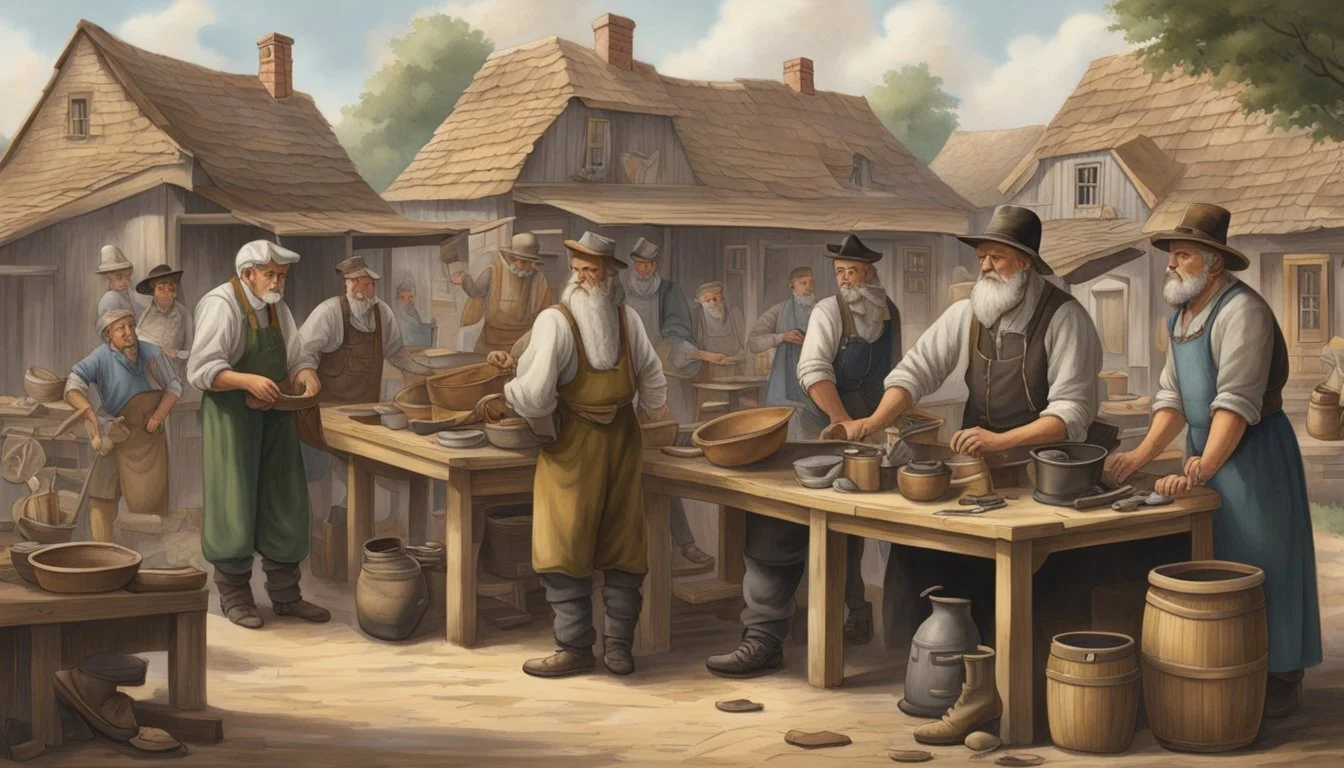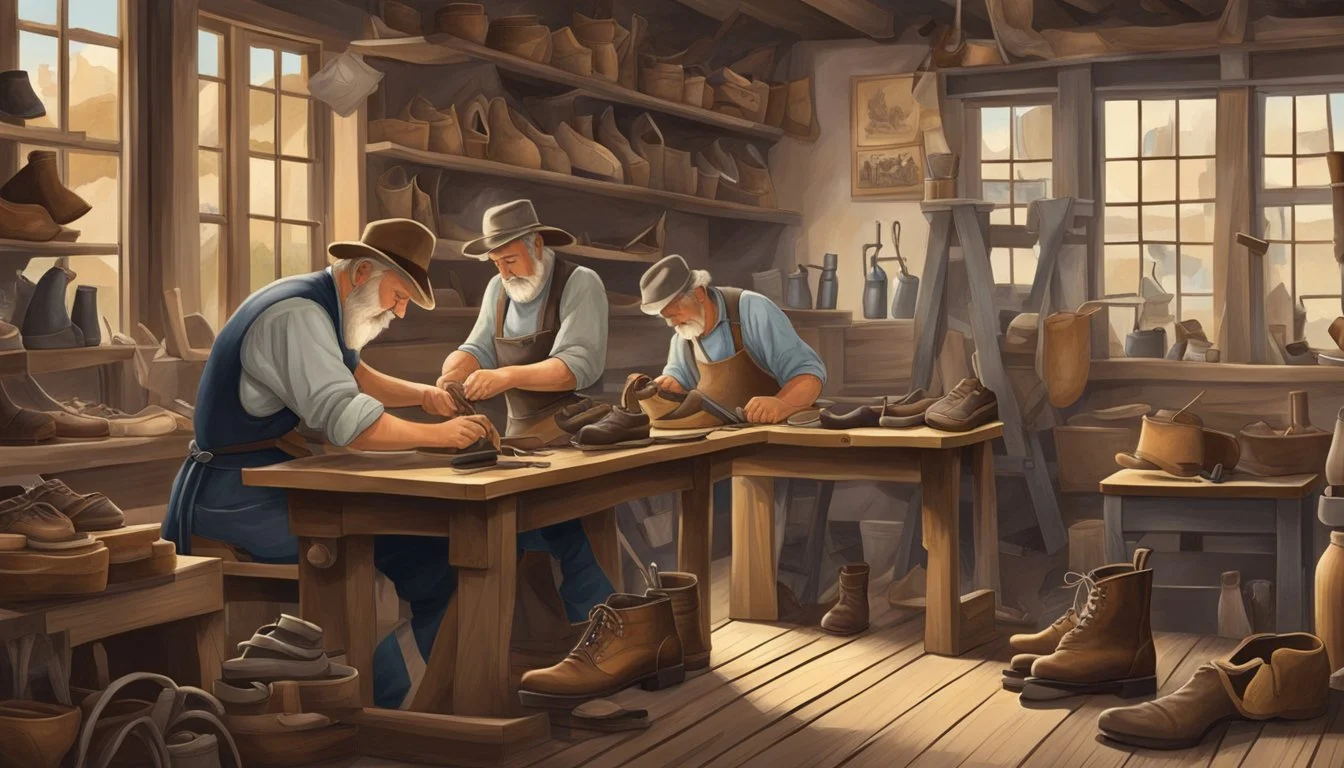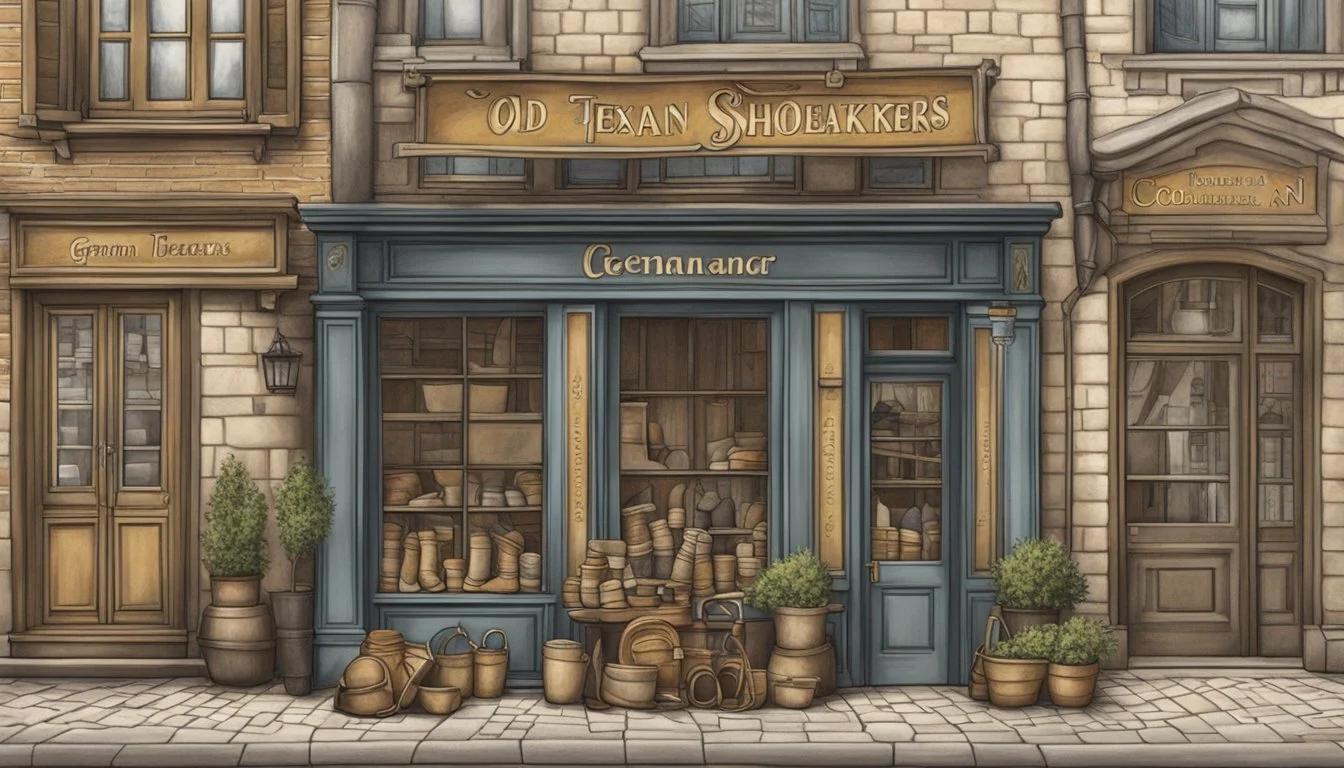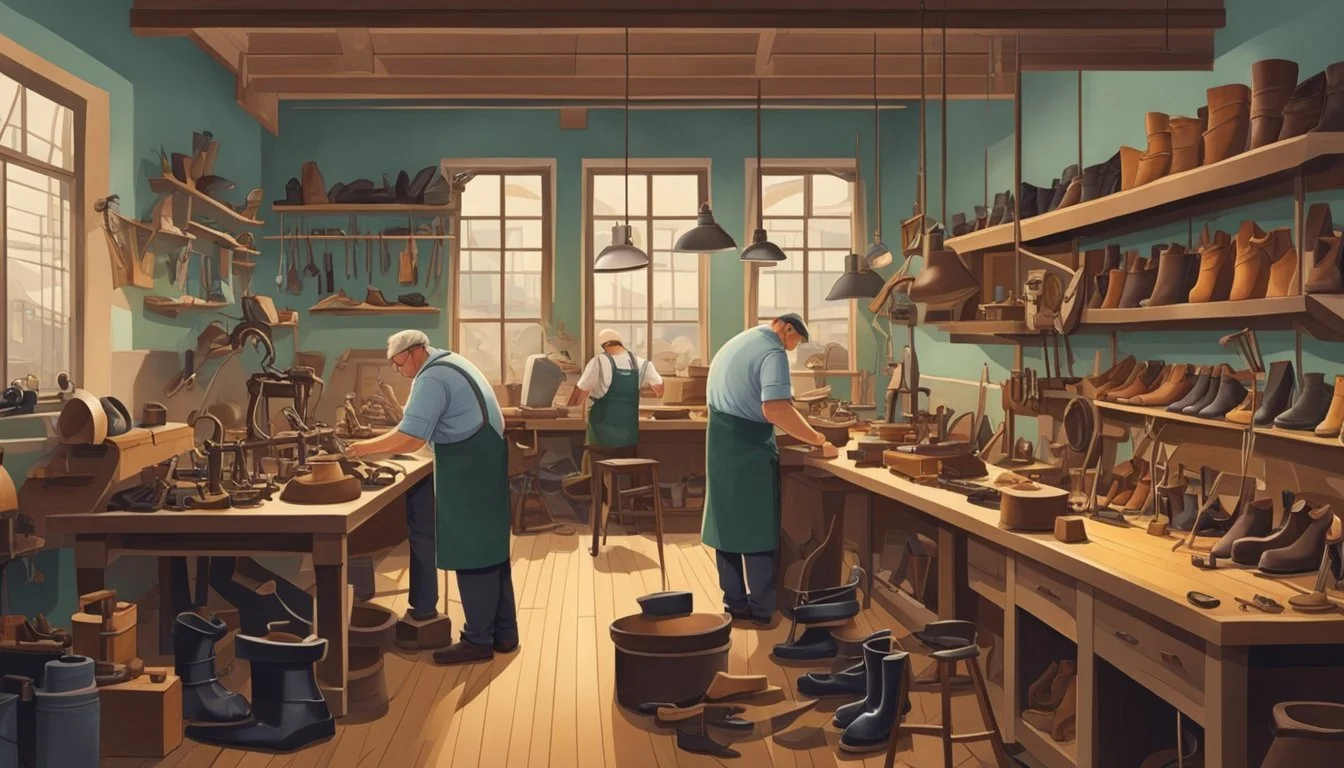The History of German Texan Shoemakers and Cobblers
A Craftsmanship Legacy
The intersection of German heritage and Texan history is a tapestry rich with artisanal trades, among which the craft of shoemaking holds a significant place. German immigrants brought their shoemaking skills to Texas during the 19th century, influencing the region with their traditional techniques and sturdy footwear. Settling in various Texan towns, German shoemakers quickly became integral to community life, establishing shops that provided not just shoes but a gathering place for locals. These craftsmen were essential in a time and place where reliable footwear was a necessity for the demanding Texan lifestyle.
Cobblers and shoemakers played distinct roles in the German Texan communities, with each profession specializing in a particular aspect of footwear. While shoemakers were artisans who created shoes from raw materials, cobblers specialized in repairing and extending the life of footwear. This distinction was a carryover from their homeland's traditions and spoke to the community's values of sustainability and thriftiness. The reliability and quality of work from these German Texan shoemakers and cobblers earned them a reputation of excellence, reinforcing their status within the local economy.
These craftsmen also played a part in the cultural preservation of their German heritage through the trade. They utilized techniques passed down through generations, which not only created a legacy of quality but also maintained a cultural connection to their roots in Germany. The influence of German Texan shoemakers and cobblers extended beyond the production of footwear, contributing to the fabric of Texan society by blending their unique heritage with the frontier spirit of the Lone Star State.
Origins of Shoemaking and Cobbling
German Texan shoemakers and cobblers have a rich history rooted in the meticulous craftsmanship and organized guilds of Medieval Europe. This tradition laid the foundation for their trades and practices.
The Roots in Medieval Europe
In Medieval Europe, shoemakers, also known as cordwainers, were skilled artisans specializing in the creation of footwear made predominantly from leather. This handicraft was not only a trade but also a tradition passed down through generations, ensuring the continuity and refinement of shoemaking techniques. The profession was held in high regard due to the essential nature of shoes in daily life.
Trade and Guilds
The organization of tradesmen into guilds was a pivotal development in the professionalization of shoemaking. Guilds served as the earliest forms of professional organizations, setting standards for quality and regulating the trade. Cordwainers, distinct from cobblers who repaired shoes, were often part of these guilds which functioned as precursors to modern unions, safeguarding members' interests and preserving the integrity of the craft.
German Texan Immigration and Settlement
The German immigration to Texas significantly shaped the local economy with the establishment of skilled trades, including shoemaking which became a common occupation among German settlers.
Arrival in Texas
German immigrants began arriving in Texas in significant numbers in the mid-19th century, a period during which the state saw a considerable increase in population due to immigration. The Adelsverein, also known as the Society for the Protection of German Immigrants in Texas, played a pivotal role in organizing and funding the migration efforts. As these settlers arrived, they brought with them their traditions, skills, and expertise in various crafts and trades, including shoemaking.
Establishing a Trade
Upon settling in Texas, German artisans, including shoemakers and cobblers, established their trade as an essential part of the growing economy. As these tradesmen rooted themselves in their new home, they:
Organized apprenticeships for young locals to learn the craft under experienced journeymen and masters.
Supported the emergence of shoemaking factories and workshops as the demand for boots and shoes grew along with the population.
Maintained a high standard of craftsmanship, preserving the reputation of German artisans which was synonymous with excellent quality and durability.
Shoemaking in the German communities followed a traditional craft structure. These German Texan shoemakers negotiated through language barriers and adapted their European craft to the needs and materials of their new environment. They continued to pass down their knowledge and skills from generation to generation, contributing to the longevity of their craft in Texas.
Shoemaking Techniques and Tools
The evolution of shoemaking in German Texan communities reflects a journey from meticulous handcrafting to mechanized production, leveraging a variety of materials and methods to ensure durability and comfort in footwear.
From Handicraft to Industrialization
In the early days, German Texan shoemakers crafted shoes predominantly by hand. These artisans, using a simple last—a form in the shape of a human foot—carved from ash or other woods, shaped the leather to create the upper parts of the shoe. They employed a distinctive set of hand tools, which included knives for cutting the leather and various devices for stitching and assembling. As cobblers, they also had the tools essential for shoe repair, ensuring longevity and maintaining the quality of the footwear.
With the advent of the industrial era, however, the craft underwent significant transformation. The introduction of the sewing machine in the 19th century revolutionized shoemaking, shifting it from a manual to an increasingly automated process. German Texan shoemakers embraced these changes, adopting the sewing machine for faster and more consistent stitching, which allowed them to increase production without sacrificing craftsmanship.
Materials and Methods
Materials:
Leather: The primary material used by German Texan shoemakers, valued for its durability and comfort.
Cloth: Occasionally used for certain parts of the shoe or for specific shoe types.
Wood and Ash: Traditional materials for making shoe lasts.
Methods:
Cutting the leather, guided by patterns to form the various shoe components like the sole, heel, and insole.
Sewing and joining these parts together, often using a welted construction for a robust bond between the sole and the upper.
Implementing a straight form last for shaping the shoe, ensuring a symmetrical and proper fit for the wearer’s feet.
In German Texan shoemaking tradition, the adherence to traditional methods was a mark of craftsmanship. These methods included the skillful manipulation of materials to form a well-fitting and comfortable shoe. Even before the full-blown industrialization of shoemaking, elements of mass-production principles were reflected in the systematized approach to making quality footwear.
Evolution of Footwear
The transformation of footwear among German Texans showcases innovations adapted to local resources and demands, reflecting an amalgamation of old-world craftsmanship and New World sensibilities.
Types of Shoes
German Texan shoemakers and cobblers crafted a variety of footwear, tailoring their designs to the functionality and resources available. Sandals, made with leather thongs, allowed for breathability in the hot Texan climate. Robust boots, often constructed with a durable sole and heel from untanned hide, became essential for the rough terrain. The clogs and moccasins, influenced by both European and Native American designs, demonstrated a practical approach, making use of the leather and materials at hand.
Moccasins: Simple in design, often made with one piece of soft leather.
Boots: Ranged from simple work boots to more elaborate riding boots.
Wooden shoes: Evoked the traditional German footwear but less common due to local preferences.
Influence of Fashion and Demand
Fashion and demand heavily dictated the shoemaking industry in the Texan German community. Influences from the Mediterranean area and Norman culture introduced the use of finer leathers and styles like the poulaines. The demand within local communities for versatile and enduring footwear led to the development of turnshoes, which had a turned-over edge for added durability. The artisans responded to regional fashion trends with adaptations such as:
Dancing shoes: Crafted to accommodate the local love for dance and festivity, emphasizing comfort and durability.
Work attire: Robust construction for farm and labor-intensive tasks.
Fashion in footwear evolved with demand, which in New England and Mittel, led to the development of industry and mechanized production, whereas in the Texan German community, the continued emphasis on handcrafted, quality work prevailed.
Notable Figures and Institutions
The history of German Texan shoemakers and cobblers is marked by the contributions of pioneering craftsmen and prominent figures who have left a significant legacy in the trade.
Pioneers of the Craft
Pioneering the profession of shoemaking in Texas were individuals like Johann, who represented the initial wave of German immigrants bringing their expertise to Texan soil. These early craftsmen adhered to traditional techniques and paved the way for future generations. They were heralded on days such as Saint Crispin's Day, the patron saint of cobblers, celebrated for their skill and dedication to the craft. Regrettably, there is no known link to other notable entities such as Jimmy Choo, Bruno Magli, or Marc Brunei in the context of German Texan shoemakers.
Prominent Texan Shoemakers
As the industry grew, standout Texan shoemakers made their mark. The search results provided did not specifically mention figures such as Thomas Crick, Christopher Nelme, or Thomas Beard, but men and women alike contributed to the shoemaking tradition, with the Daughters of St. Crispin representing the women in this skilled occupation. Contextually, however, names like John Smith would have been common among English settlers rather than German Texans and thus may not be a direct reference to the shoemaking industry in this particular heritage.
Cultural Significance and Practices
In the rich tapestry of Texas history, German Texan cobblers and shoemakers have played a pivotal role in both preserving their tradition-laden craft and shaping the economic and social landscapes of their communities.
Tradition and Lifestyle
Customs and Craftsmanship: German Texan shoemakers, or cordwainers, were more than just footwear artisans; they were the carriers of a deep-rooted cultural heritage. Their trade practices stemmed from a long history of shoemaking, which in Europe was often regulated by guilds that upheld rigorous standards—standards that German immigrants brought with them to Texas. The practice encapsulated a lifestyle, intertwining daily routines, values, and the transmission of skills from one generation to another, ensuring the preservation of their crafted legacy.
Economic and Social Impact
Guild Influence and Nobility Support: The craft of shoemaking was historically supported by nobles, who recognized the importance of the trade and the need for its regulation through guilds.
Economic: The shoemaking trade significantly contributed to the local economies, as it was a necessity for the burgeoning population of Texas. German Texan shoemakers established themselves not just as merchants but as vital components of the town's economic framework.
Social: Socially, these craftsmen created a nexus for discourse and community bonding, often serving as gathering points in towns. Their shops became social landmarks where people shared news and formed close-knit relationships, reinforcing the social fabric of their communities.
Modern Developments and Trends
German Texan shoemakers and cobblers have seen significant changes in their craft with the introduction of new technologies and a shift towards contemporary practices in both shoemaking and shoe repair.
Technological Advancements
Industrialization played a pivotal role in the evolution of shoemaking. Modern German Texan shoemakers utilize advanced sewing machines that have significantly increased production speeds and efficiency. These machines offer precise stitching techniques like Blake-stitching, mainly used in creating formal and durable shoes. Additionally, innovations have extended to the materials used, with jute and other synthetic materials being employed alongside traditional leather to offer diverse footwear options.
Sewing Machines: Adaptive to various stitching styles such as Norwegian, turnout, and Blake-stitched
Materials: Introduction of sustainable materials alongside classic leather
Production Methods: Automation in cutting and assembling parts, reducing manual labor
Contemporary Shoemaking and Repair
Modern German Texan cobblers and shoemakers have adapted their practices to cater to a market that values both traditional bespoke shoes and mass-produced footwear. They respect the rich heritage of handcrafted turn shoes while also offering repairs that integrate modern techniques and materials. The repair side of the business has evolved with contemporary techniques to extend the life of both traditional and modern footwear, offering services like resoling and restitching using advanced equipment.
Bespoke Footwear: Continued demand for custom-made shoes with personalized fittings
Repair Practices: Use of modern machinery for intricate repair work, often blending old and new methods
These developments reflect the industry's ability to preserve traditional craftsmanship while embracing innovation to meet current market demands.
Preservation of the Craft
Within the German Texan community, the high standards of craftsmanship have been maintained through continuous education and by embracing time-honored shoemaking techniques. This ensures that both the tradition and quality of the shoemaking craft endure into the future.
Education and Apprenticeship Programs
German Texan shoemakers have traditionally placed great emphasis on the education and training of new artisans through apprenticeship programs. These programs are designed to create a robust learning environment where apprentices are taught the intricacies of shoemaking by seasoned craftsmen. Apprentices usually begin their journey working alongside a master cobbler or shoemaker, learning various techniques and nuances of leatherwork, sole shaping, and stitching. This hands-on learning approach is fundamental in preserving the artisanal approach to shoemaking that defines German Texan craftsmanship.
Apprentices: Newcomers who learn the craft through hands-on experience.
Journeymen: Artisans who have completed their apprenticeships, demonstrating improved skills and working towards mastery.
Master Shoemakers: Highly skilled craftsmen, typically with many years of experience, responsible for training apprentices.
Revival of Traditional Methods
Post the American Revolution, there was an increasing desire among German Texan cobblers to revive traditional shoemaking methods. These artisans recognized the importance of traditional techniques in crafting high-quality and durable footwear. By eschewing mass production methods and focusing on individual craftsmanship, German Texan cobblers ensure that each pair of shoes is a testament to their skill and attention to detail. The use of traditional tools and methods not only connects them to their cultural heritage but also to a global tradition of fine shoemaking.
Traditional Tools and Techniques: Methods passed down through generations and still in use today.
Quality: A core focus of German Texan shoemakers, associated with both the materials used and the finished product.
Revival Efforts: Initiatives that emphasize the importance and value of traditional shoemaking methods.
The Business of Shoemaking
In the context of German Texan immigants, the business of shoemaking and cobbling was not only a craft but also a vital trade that encapsulated both the economic and social aspects of their communities. These artisans found ways to thrive despite the changing times brought by industrialization.
Running a Cobbling Shop
Shoemaking in the German Texan communities was characterized by meticulous craftsmanship. A typical cobbler's shop was an all-encompassing venture where both the creation and repair of footwear took place. The shoemaker served a dual role, manufacturing new shoes and maintaining or fixing old ones. This versatility was essential for a cobbler’s economic resilience.
Inventory: Shops kept a range of materials for making and repairing shoes, such as leather and tools.
Services: German Texan cobblers offered a variety of services, including custom shoe creation and standard repairs.
Economic Challenges and Opportunities
German Texan shoemakers and cobblers were deeply entrenched in the local trade system. However, they faced economic challenges including the rise of shoe factories, which could produce footwear more quickly and cheaply. These changes led to a diversity of economic outcomes:
Challenges: Industrialization brought competition from mass-produced shoes, narrowing the market for handmade footwear.
Adapting to Industrialization:
Some craftsmen embraced new methods, incorporating factory-made parts into their traditional craft.
Others focused on specialized repairs or bespoke shoes to maintain a niche in the market.
The rise of industrialization and shoes produced en masse by factories presented both a threat and an opportunity. On one hand, it pressured the traditional shoemaking trade, but on the other hand, it led to new niches in repairs and bespoke craftsmanship. By balancing the preservation of their artisanal heritage with the adoption of new techniques and market strategies, German Texan cobblers and shoemakers maintained their relevance in both economic and social terms.
Conclusion
German Texan shoemakers and cobblers have contributed significantly to the cultural tapestry through their impeccable craftsmanship and adherence to tradition. Throughout the history of German Texans, one can trace the meticulous work of shoemakers, evidencing a reverent continuation of the skills passed down from generation to generation.
In small towns and communities, the presence of thriving leather workshops signaled both the necessity and the luxury of customized footwear, and cobblers stood as essential figures, ensuring the longevity of each pair of shoes. Cobbling, which involved more than just the repair of shoes, became an eco-friendly practice long before sustainability entered the common lexicon. This profession embodies the intersection of practicality and artisanal heritage.
Craftsmanship, a cornerstone of the German Texan identity, was not only about the creation of shoes but also about preserving a cultural legacy. Cobblers and shoemakers were curators of their craft, blending German meticulousness with the resilience required in their new Texas environment. Their work extended beyond economic contribution; they molded a visible and tangible piece of German Texan history.
Despite modern advancements in shoe manufacturing, the value of handcrafted footwear endures among German Texans, as it represents both the artistry of traditional shoemaking and the individualistic spirit of customization. These artisans, with their rich contributions, have ensured that a piece of German Texan tradition marches on into the future, with every step taken in shoes shaped by generations of skilled hands.











